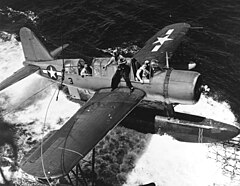Vought OS2U Kingfisher
 Vought OS2U Kingfisher (1944) | |
| Dane podstawowe | |
| Państwo | |
|---|---|
| Typ | wodnosamolot rozpoznawczy, obserwacyjny i łącznikowy |
| Konstrukcja | metalowa |
| Załoga | 2 osoby |
| Historia | |
| Data oblotu | lipiec 1938 |
| Lata produkcji | 1940–1945 |
| Wycofanie ze służby | 1959 |
| Dane techniczne | |
| Napęd | 1 gwiazdowy silnik tłokowy Pratt & Whitney R-985-AN2 Wasp Junior |
| Moc | 457 KM |
| Wymiary | |
| Rozpiętość | 10,97 m |
| Długość | 10,25 m |
| Masa | |
| Startowa | 2722 kg |
| Osiągi | |
| Prędkość maks. | 264 km/h |
| Zasięg | 1858 km |
| Dane operacyjne | |
| Uzbrojenie | |
| 2 karabiny maszynowe kal. 7,62 mm; zaczepy dla 295 kg bomb | |
| Użytkownicy | |
| USA, Wielka Brytania, ZSRR, Chile, Urugwaj | |
Vought OS2U Kingfisher (ang. zimorodek) – wodnosamolot rozpoznawczy (OS – „Observation-Scout”, „obserwacyjno-zwiadowczy”) produkcji amerykańskiej, używany w czasie II wojny światowej.
Był to niewielki samolot o przeciętnych osiągach, głównie z powodu lekkiego silnika o niskiej mocy. Pod samolotem zamontowany był jeden duży centralny pływak i dwa mniejsze pod skrzydłami, budowany był także w konfiguracji lądowej ze stałym podwoziem. Używany był głównie jako samolot obserwacyjny startujący z katapult na pancernikach i krążownikach.
Kingfisher był używany również do zwalczania okrętów podwodnych i jako samolot ratowniczy. Z powodu niewielkiego udźwigu jego przydatność do tych zadań była jednak bardzo ograniczona – znany jest incydent z 1942, gdy załoga OS2U uratowała trzech członków załogi samolotu B-17, który został zmuszony do wodowania na Pacyfiku. Ciężar dodatkowych trzech osób spowodował, że samolot nie mógł się oderwać od powierzchni wody i był zmuszony „dokołować” do najbliższego lądu oddalonego o 60 km.
Linki zewnętrzne

Media użyte na tej stronie
US Flag with 48 stars. In use for 47 years from July 4, 1912, to July 3, 1959.
A U.S. Navy Vought OS2U-2 Kingfisher (BuNo.3117) seaplane in flight in early 1942.
A U.S. Navy Vought OS2U-3 Kingfisher floatplane is hoisted on board the USS Missouri (BB-63) after a flight, during the ship's shakedown cruise, circa August 1944.
Roundel used by US armed forces from 6 May 1942 to 28 June 1943 when white bars and a red outline were added as the result of studies which showed that shape was more important than color from a distance.
Autor: NiD.29, Licencja: CC-BY-SA-3.0
Roundel used by all US armed forces from 31 July 1943 to 14 January 1947, replacing roundel having red outline, or no outline, but with white bars, and was replaced some nine months before the USAF was formed, by roundel having a single lengthwise red bar inset in white bars (bisecting them), giving the insignia the trio of red-white-red stripes evocative of the non-canton areas of the Flag of the United States.
A U.S. Navy Vought OS2U-3 Kingfisher is recovered by the heavy cruiser USS Baltimore (CA-68) after she had rescued Lieutenant (JG) George M. Blair from Truk Lagoon, 18 February 1944. The plane's pilot was Lieutenant (JG) Denver F. Baxter. His radioman, ARMC Reuben F. Hickman, is on the wing, preparing to attach the plane so it can be hoisted on board. Blair's Grumman F6F Hellcat of Fighting Squadron 9 (VF-9), from the aircraft carrier USS Essex (CV-9), had been shot down during the dawn fighter sweep over Truk.
Roundel used by the United States armed forces from 19 August 1919 to 6 May 1942 until red dot removed to avoid confusion with Japanese insignia. Superseded very similar roundel whose colors and proportions differed slightly - the original version having the colors from the US flag, and a center dot 1/3 of the outer radius. This version has a center dot constrained by the inner vertices of the star, a size that does not translate into an even fraction.










